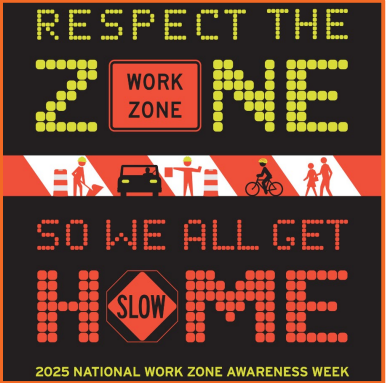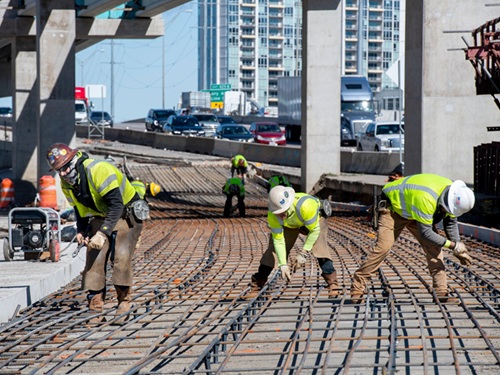Across the country, state departments of transportation, contractors, and other transportation organizations held events in support of the annual National Work Zone Awareness Week or NWZAW campaign – with some even launching special programs aimed at helping reducing roadway work zone crashes.
[Above photo by the NCDOT]
Sean Duffy, secretary of the U.S. Department of Transportation, stressed the 2025 NWZAW campaign’s “Respect the Zone So We All Get Home” theme in a video address that underscored how critical it is for drivers to make safety a priority when driving through work zones. “Safety is my top priority,” he stressed. “Together, we can usher in a golden age of travel while making our work zones – and our roadways – safe for everybody.”
As the 2025 roadway construction season ramps up, the Federal Highway Administration is reminding drivers to slow down in and near work zones on highways and roadways to help prevent fatalities where crews are on the job. FHWA noted that, from 2021 to 2023, work zone fatalities decreased by nearly 7 percent according to National Highway Traffic Safety Administration data. The agency stressed, as part of its 2025 NWZAW messaging, that it will continue to help improve safety in work zones to “sustain this trend.”
“Everyone plays a role in work zone safety,” said Gloria Shepherd, FHWA’s executive director, in a statement. “Highway workers face some of the toughest conditions because their jobs require them to work in areas very close to high-speed traffic. By staying alert, drivers can help workers do their jobs safely and arrive home when their work is done.”

The North Carolina Department of Transportation served as the “host” for the 2025 national NWZAW event, holding an event at the North Carolina State Fairgrounds on April 22 featuring national and state transportation officials, safety advocates, and construction workers to officially kick off the yearly effort to highlight the risks faced by roadway workers across the country on a daily basis.
“The safety of our roadway workers and the traveling public is a top priority,” stressed Joey Hopkins, NCDOT secretary, in a statement. “The dedication of these individuals who work tirelessly on our highways, often near fast-moving traffic, to improve the infrastructure in our state is commendable. [This] kickoff [event] is a reminder to everyone of their responsibility to reduce driving speed, remain attentive and travel cautiously when approaching a work zone.”
He said NCDOT has started using new tools to make work zones safer, including connected work zone devices that transmit the location of the work zone to navigation apps like Waze, which give drivers an audible alert when they are approaching a work zone.
“Safety is critical to all our projects from start to finish,” Hopkins added. “We’ve used digital messages, road construction signs, flashing arrows, portable traffic signals and automated flagging assistance devices.”

The Connecticut Department of Transportation helped host a 2025 NWZAW event that included remarks from local, state, and federal officials, as well as the family of Andrew DiDomenico, a CTDOT worker tragically killed on the job in 2024.
“Roads are not racetracks,” noted CTDOT Commissioner Garrett Eucalitto – who also serves as the president of the American Association of State Highway and Transportation Officials – in a statement. “This past year has been especially difficult for us at CTDOT as we lost one of our own, Andrew DiDomenico, in a tragic work zone crash. We need drivers to slow down, stay alert, and Obey the Orange because their choices behind the wheel impact real people, real families, and entire communities.”
The Georgia Department of Transportation touted several educational initiatives as part of its 2025 NWZAW efforts – as well as touting the “Spencer Pass Law,” also known as the “Move Over Law” that requires drivers to move over one lane when possible if an emergency vehicle with flashing lights is parked on the shoulder of the highway. If traffic is too heavy to move over safely, motorists are instead required to slow down below the posted speed limit and prepare to stop, the agency said.

Georgia DOT noted that this law was named in memory of Spencer Pass, a Highway Emergency Response Operator who lost his life on I-85 while assisting a motorist in 2011.
“Far too many families have experienced the heartbreak of loved ones never returning home due to work zone related crashes,” said Georgia DOT Commissioner Russell McMurry – who also serves as AASHTO’s vice president – in a statement. “What you do behind the wheel has lasting consequences. Please drive responsibly in and around work zones to keep everyone safe.”
As part of its 2025 NWZAW campaign efforts, the Kansas Department of Transportation launched “Kansas Work Zone Safe,” a free online driving course aimed at teaching teenagers and other new drivers how to safely navigate through work zones. The course includes information on safe behaviors, laws, and situations drivers may encounter in work zones, the agency said.
“Behind every flag, cone and flashing light are highway workers and first responders who have families that want them to come home every night,” said Haley Dougherty, Kansas DOT’s state highway safety engineer, in a statement. “This course is designed to raise awareness in new drivers about safe driving practices in work zones, which should make the work zone safer for all.”

To help remind motorists – both current and future – of the importance of staying focused while in a work zone, the Texas Department of Transportation called on the creativity of local students.
“We figured if there was a way to get the message to the younger generation, then they would be more inclined to call their parents out on not wearing a seatbelt or speeding,” noted Jill Christie, a TxDOT traffic safety specialist in Abilene, TX, in a statement. “And maybe, just maybe, once they were old enough to drive themselves, the messages would have stuck, and it would be a natural action vs an action that needed to be changed.”
Local high school students were tapped to create a poster centered around work zone awareness, with the winning poster becoming a coloring sheet for the next year’s elementary aged students.
“We wanted to create something around work zone awareness that would span several years, not just one year,” Christie said. “By bringing the contest to both high school and elementary aged students, we not only have something that reaches both demographics, but we have the opportunity to continue this for years to come.”
Several state DOTs held remembrance ceremonies as part of their 2025 NWZAW efforts; honoring workers who have lost their lives in the line of duty.

For example, the Colorado Department of Transportation held its annual observance of Remembrance Day on April 22; honoring the 64 employees who have died in the line of duty since 1929, including the names of Trenton Umberger and Nathan “Nate” Jones who died on the job in 2024.
“As we unveil the etchings on [our] memorial stone, wishing that we did not have to add any more names, let alone two, we must redouble our commitment to remembering our two coworkers and working together to do everything we can to make the roads safer for the hard working highway maintainers who, each day, take risks to keep the roads safe for the traveling public,” said Shoshana Lew, Colorado DOT’s executive director, in a statement.
While highway workers are at great risk every day, it is just as critical for motorists to be safe and responsible in work zones for themselves, she said. In fact, four out of five work zone fatalities are people driving through work zones, not highway workers, Colorado DOT noted.
“Our maintenance crews work every day to keep Colorado safely moving. It is dangerous but vital work. On Remembrance Day we honor those who didn’t make it home so others could,” said Shawn Smith, director of maintenance and operations for the agency. “We continue to improve procedures to try to keep everyone safe, but we also need the travelling public to slow down and pay attention in work zones as that final piece of the safety puzzle.”

The Virginia Department of Transportation held a similar ceremony at its now 20-year-old highway worker memorial located along I-64 on Afton Mountain.
“[Our] workers face risks every day working to maintain and improve our roads, highways and bridges,” said Virginia DOT Commissioner Stephen Birch in a statement. “Our people are the backbone of our agency and are dedicated to the mission, but at the same time, they have families, friends, pets and hobbies outside of work. It’s critical for drivers to observe work zone signage, lowered speed limits and traffic pattern changes to help ensure workers make it home.”
“Driving cautiously in work zones helps families,” said Dan McElhinney, chief deputy and chief operations officer for the Idaho Transportation Department, in a statement. “Travelers, workers, and their loved ones all benefit when drivers reduce crash risks by driving slower and staying alert for traffic cones and guiding signage. Our employees are working hard to improve roadways and quality of life; driving safely near road work is one of the best ways to support that effort.”
“The people working in work zones are real people – our neighbors, friends, and family,” noted Kris Strickler, director of the Oregon Department of Transportation, in a statement. “They’re out there every day improving the roads we all rely on. As drivers, we owe it to them to slow down, stay alert, and move over when we can. Their safety is in our hands.”



